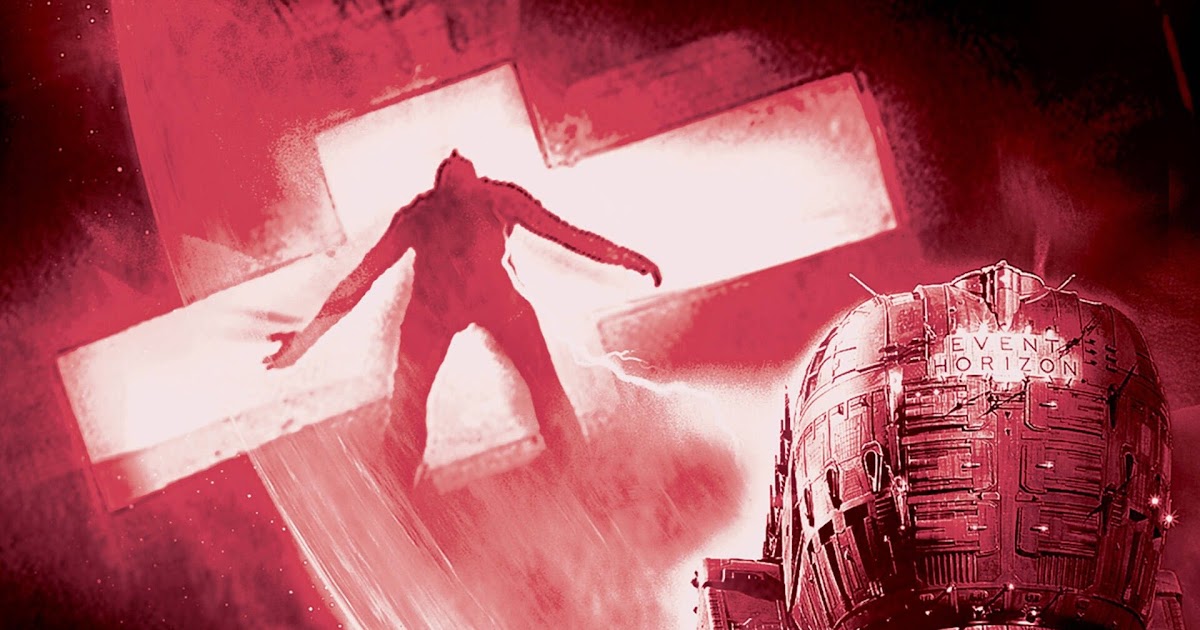Event Horizon is a 1997 Anglo-American-Canadian science fiction/horror movie that starts off as a blatant rip-off of Alien but then heads off in a totally new direction.
In 2040 the experimental spaceship Event Horizon disappears without trace in the vicinity of the orbit of the planet Neptune. The craft was designed for deep space exploration but the exact nature of its mission and the exact nature of the spacecraft itself are top-secret. Seven years later a transmission is picked up from the Event Horizon. It’s a very strange transmission which is suddenly cut off. But it’s enough to justify sending a rescue mission.
The rescue ship is the Lewis and Clark. The crew is the usual assortment you expect in such a science fiction movie. There’s the very serious martinet Captain Miller (Laurence Fishburne) who has a deep sense of duty. There’s a rebellious misfit. There’s a female medical lab technician who is tortured by personal problems. There’s the young rookie who will almost certainly crack up under pressure. There’s Starck (Joely Richardson), an essential member of the crew because without her the movie wouldn’t have a sexy female cast member.
And of course there’s the outsider, a scientist named Weir (Sam Neill). Naturally the crew don’t trust him. It’s always a bad idea to trust scientists. They trust him even less when they find out that he was the designer of the Event Horizon, and they really really don’t trust him at all when they find out the Event Horizon’s secret. That ship was built to test a gravity drive that would create artificial wormholes allowing faster-than-light travel. At the heart of the gravity drive is a black hole. Black holes are dangerous. Everybody knows that.
They find the Event Horizon easily enough. It’s deserted. They do find bloodstains. Lots of bloodstains. We know what’s going to happen next. Monsters are going to appear. But that doesn’t happen. There is evil aboard the Event Horizon, but it’s a different kind of evil. This is where this movie departs radically from Alien.
It become clear that the gravity drive had worked, after a fashion. The Event Horizon certainly left our solar system. Where it went to is unknown. How it got back is unknown.
The original script was a standard Alien rip-off. Director Paul W.S. Anderson wasn’t interested in doing it unless it was totally rejigged. Anderson wanted to make a ghosts in outer space movie. More specifically he wanted to make a haunted house in space movie. A movie that would draw heavily on two of his favourite movies, Robert Wise’s The Haunting (1963) and Kubrick’s The Shining. Anderson wanted to do what Wise and Kubrick had done – not show any actual monsters or ghosts. The evil would be formless, nameless, inexplicable, mysterious and invisible. The audience would see plenty of evil and horror, but all of it would be the consequence of that formless invisible evil.
One of this movie’s strengths is that it doesn’t offer a clear-cut explanation. There is mention of Hell but it would be simplistic to believe that the spacecraft had literally traveled to Hell. It may however have gone somewhere equally nasty, a place that would seem like Hell. We don’t know where the evil comes from or where it resides. We don’t know what it wants. We don’t know if it’s sentient.
The Event Horizon spacecraft is a bit like the Overlook Hotel, but in space. And maybe Weir is a bit like Jack Torrance.
Things get progressively weirder and nastier. With lots of gore and splatter.
I must confess that this is the only Paul W.S. Anderson movie I’ve ever seen. This is a movie in which the characters don’t matter much and the plot is deliberately vague. It’s all about the atmosphere of dread and doom, and even more emphatically it’s all about the visuals.
And the visuals are spectacular. There’s some CGI but Anderson wanted to rely mostly on practical effects. The spacecraft interior sets are impressive, with a bit of a high-tech grunge feel. The miniatures work is extremely good.
Anderson wanted a religious feel. He wanted the design of the Event Horizon to be based on the Cathedral of Notre Dame and surprisingly it’s an idea that works. He also wanted hints of stained glass windows. And curves. Lots of curved surfaces.
Event Horizon is not trying to be particularly profound. Anderson was not tying to make Citizen Kane in space, or The Seventh Seal in space. He wanted to make a horror movie about a haunted spaceship that would be weird and creepy and scary and on the whole he succeeded. It certainly is mostly a collection of ideas from other movies but they’re combined effectively and in a reasonably original way. Event Horizon is a big-budget popcorn movie but it’s fine entertainment. Highly recommended.
The Blu-Ray looks terrific and there are lots of extras including a commentary track by the director and the producer.




